Nest videos from Peru
all images © Mark
Chappell and the Manu Project
For several years I've been involved in a study of altitude distributions in Andean bird communities. These videos are from motion-sensing cameras placed near nests to record parental and nestling behavior, but they also show nest predation -- which is very high in tropical forests. The videos are of low quality, but give an idea of how difficult it is for birds to produce offspring in these predator-rich habitats.
This video gives a good overview of the project.
|
| Daytime nest predation
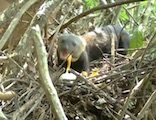 | Tyras are large tropical weasels, similar to the martens of boreal forests. In this video a family of tyras raids the nest and steals eggs from a speckled chachalaca. | |
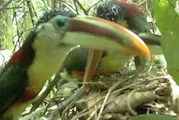 | Toucans and toucanets are important predators of bird nests, in addition to their main diet of fruit. Here a group of curl-crested aracaris takes the eggs of a gray-fronted dove.
| 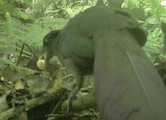 | A rufous-vented ground cuckoo takes the eggs of a ruddy quail-dove, despite protests by the incubating parent. | | 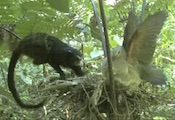 | A group of saddle-backed tamarins steal eggs from a gray-fronted dove nest, despite the protests and threats of the parent.
| 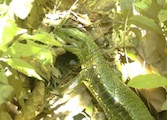 | Many nests are lost to reptiles, especially snakes. However, large lizards are also a threat. Here, a golden tegu raids a pectoral sparrow nest. |
| 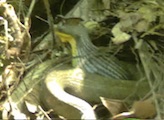 | Snake predation is very common, and at low altitudes it is a major cause of nest failure. Here a common 'bird snake' (Pseutes) predates the nest of a Goeldi's antbird. | |
| Nightime nest predation
 | A small opossum raids the nest of a thrush (we don't know the species of opossum; there are several in our study area and examination of the skull is necessary for correct identification). |
| 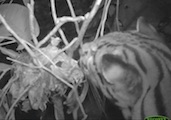 | A male ocelot discovers a nest in a low bush and eats the nestling. |
 | Nightjars (such as this lyre-tailed nightjar, seen at the start of the video) use their camouflaged plumage to hide themselves and their nests on the ground, but it doesn't always keep them safe from owls (here, a barn owl). | |
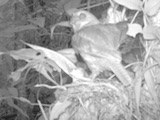 | This ferruginous pygmy owl repeatedly returns to a red-crowned ant-tanager nest, removing all of the nestlings. Between the owl's visits, the owner returns to inspect its nest. | |
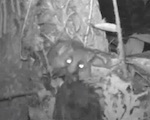 | Most nest predation events result in loss of the eggs or nestlings, but occasionally -- as in this video of a small opossum -- a parent bird (here, a Schiffornis) may also be killed. | |
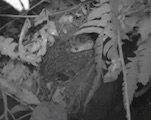 | Snake predation may also occur at night, as in this video, which has some narration (not by me). The snake is another Pseutes and the nest belongs to a spot-winged antbird. | |
| Other
|
|  | In color, shape, and behavior, nestlings of cinereous mourners mimic certain large caterpillars with venomous spines. These are probably the first videos of the nestlings of this little-known species.
| | 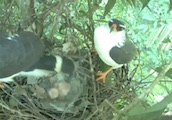 | White-browed hawks are rare, strikingly-marked forest birds, and this is probably the first movie of their nest behavior. Near the end, both parents can be seen with their newly-hatched chick.
| | |
|
| |















